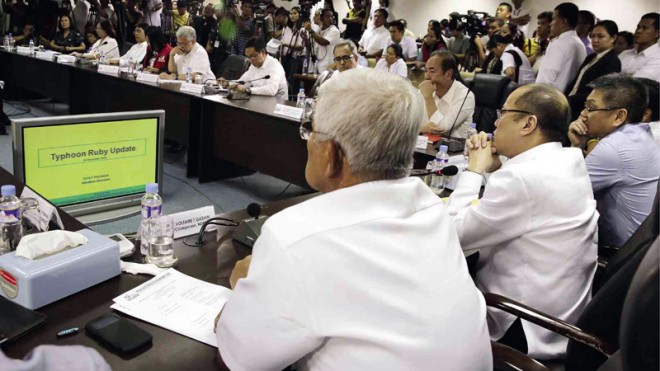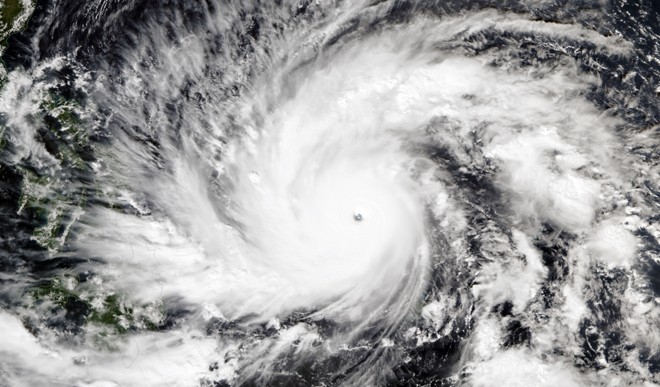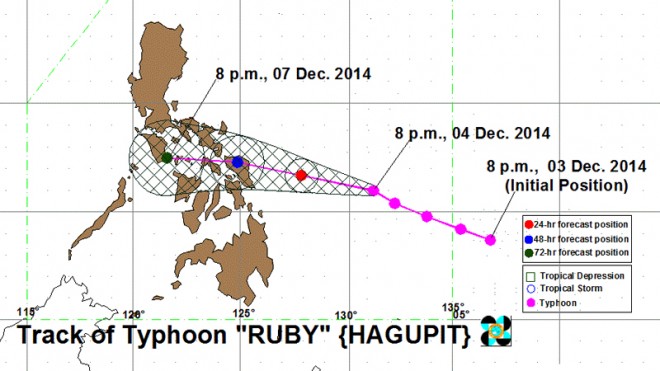‘Ruby’ packs peak winds of 350 kph

BRACING FOR SUPERTYPHOON President Aquino presides over a meeting of top Cabinet and government officials in Quezon City to evaluate the country’s preparedness in anticipation of Typhoon “Ruby,” which is expected to make landfall on Saturday. MALACAÑANG PHOTO BUREAU
“Let’s prepare for everything,” President Benigno Aquino III told a nationally televised meeting of disaster agency chiefs on Thursday as the Joint Typhoon Warning Center (JTWC) in Hawaii upgraded Typhoon “Ruby” (international name: Hagupit) into a supertyphoon.
The JTWC said Ruby was heading toward the Philippines with maximum sustained winds of 287 kilometers per hour and gusts of 351 kph.
The joint US Navy-US Air Force weather station categorizes a typhoon as a supertyphoon if it brings maximum sustained winds of 220 kph.
But the Philippine Atmospheric, Geophysical and Astronomical Services Administration (Pagasa) categorizes Ruby only as a typhoon, and said on Thursday that it was likely to slam into the same central islands smothered by Supertyphoon “Yolanda” (international name: Haiyan) on Nov. 8 last year.
Pagasa said the typhoon, which entered the Philippine area of responsibility early on Thursday, was expected to make a landfall in the Samar area on Saturday morning.
Intensity ‘violent’
But the JTWC said Ruby was likely to recurve to the northwest toward southern Luzon. If that happens, the supertyphoon will hit Metro Manila.
The JTWC forecast Ruby to have maximum sustained winds of up to 305 kph and gusts of 370 kph by 2 a.m. on Saturday.
In its bulletin on Thursday afternoon, the Japan Meteorological Agency (JMA) categorized Ruby’s intensity as “violent.”
According to the JMA, Ruby, moving west-northwest at 26 kph, had maximum sustained winds of 212 kph and gusts of 370 kph.
The JMA also expected Ruby to recurve to the northwest and hit southern Luzon.
The Hong Kong Observatory (HKO) said that as of 4 p.m. on Thursday, Ruby was centered some 1,260 km east-southeast of Manila.
According to the HKO’s bulletin, Ruby was forecast to have maximum sustained winds of 205 kph on Friday morning and 220 kph on Saturday morning.
It said Ruby was expected to move west-northwest about 25 kph in the general direction of central Philippines.
Former Pagasa forecaster Nathaniel Cruz said on television on Thursday that it was difficult to say whether the different trackings would be reconciled at some point before Ruby hit land.
But he maintained that Ruby would cross Central Visayas, the same region ravaged by Yolanda last year.
Different measurements
The measurement of maximum sustained winds used by the JTWC is different from the measurement used by forecasting centers outside the United States.
The JTWC averages wind speed every minute while the meteorological services in the Philippines, Japan, Australia and other countries in the Pacific use the 10-minute average.
“The difference generally means that JTWC will report higher maximum sustained surface wind speeds than non-US tropical cyclone forecasting centers for the same cyclone,” the JTWC said on its website.
According to Pagasa forecaster Criz Perez, Ruby was spotted at 720 km east of Surigao City as of
4 p.m. on Thursday, with maximum sustained winds of 205 kph and gusts of up to 240 kph and moving west-northwest at 15 kph.
Storm Signal No. 2 was raised over Northern Samar, Eastern Samar, Samar, Biliran, Leyte, Southern Leyte as well as Dinagat and Siargao islands, where winds of 61 kph to 100 kph were expected.
Sea and air travel in those areas were risky.
Storm Signal No. 1 was raised over Catanduanes, Albay, Sorsogon, Ticao Island, Masbate, Northern Cebu (including Bantayan Island), Camotes Island, Bohol, Surigao del Norte, Surigao del Sur, Camiguin Island and Agusan del Norte.
Winds of 30 kph to 60 kph were expected in those areas. Sea travel by fishing boats and other small vessels was risky.
The estimated amount of rainfall within the 700-km diameter of the typhoon was heavy to intense at 7.5 millimeters per hour to 20 mm per hour.
Perez warned residents in areas under Storm Signal Nos. 1 and 2 to expect flash floods and landslides, and alerted people living in coastal areas to possible storm surges of 3 meters to 4 meters.
Areas heavily affected
Earlier on Thursday, Pagasa said the areas expected to be heavily affected by Ruby were Aklan, Albay, Antique, Biliran, Capiz, Cebu, Eastern Samar, Iloilo, Leyte, Marinduque, Masbate, Northern Samar, Occidental Mindoro, Oriental Mindoro, Palawan, Quezon, Romblon, Samar and Sorsogon.
Also expected to be affected were Batangas, Bohol, Camarines Norte, Camarines Sur, Catanduanes, Cavite, Guimaras, Laguna, Metro Manila, Negros Occidental, Negros Oriental, Southern Leyte, Surigao del Norte, Rizal, Agusan del Norte, Agusan del Sur, Aurora, Bataan, Bulacan, Camiguin, Nueva Ecija, Pampanga, Surigao del Sur, Tarlac and Zambales.
50 provinces to feel wrath

This image made available by the National Oceanic and Atmospheric Administration (NOAA) and captured by the Suomi NPP satellite’s VIIRS instrument shows Typhoon Hagupit on Thursday, Dec. 4, 2014, as it approaches the Philippines. AP/NOAA
With 50 of 80 provinces in the country projected to feel the wrath of Ruby, President Aquino wants all agencies and local governments to brace for the impact.
“I will not be very patient with excuses,” Mr. Aquino warned agency heads gathered on Thursday at the National Disaster Risk Reduction and Management Council (NDRRMC) conference room, reminding them that they should have already taken precautions in priority areas.
Priority areas include the evacuation of people who are expected to be affected by the typhoon, food, water, shelter, communications and mobility.
Mr. Aquino encouraged all officials involved in the preparations and disaster response to be busy and not to hope that “things will trickle up or down.”
“Ruby presents a challenge. But we have been challenged before by Yolanda,” the President said, adding that the government’s job at this point was to calm down the public by assuring them that preparations had been undertaken.
Mr. Aquino directed the agencies to deal with reports of panic buying and hoarding in areas expected to be hit by the typhoon.
He ordered the deployment of “rolling stores” to ensure sufficient supply of basic commodities.
The President particularly wants the availability of rice assured and warehouses, where food and other relief goods are stored, to be secured.
While police and military forces have been placed on full alert, the President wants those who fail to report for duty to be immediately declared “absent without official leave.”
The deployment of police officers, specifically in commercial areas, is to preempt “hooliganism, looting and panic,” Interior Secretary Mar Roxas said.
According to Roxas, based on Pagasa’s forecast, 50 of 80 provinces have been placed on alert.
He said the extent of preparations covered 995 municipalities and 85 cities expected to be affected by the typhoon.
‘Zero casualty’
Drawing lessons from Yolanda, Malacañang urged residents of communities in the path of Ruby to heed calls to evacuate.
Communications Secretary Herminio Coloma reiterated the government’s “aspiration” for “zero casualty.”
“We appeal to our people to immediately follow warnings and cooperate in the measures being implemented by the different government agencies,” Coloma told reporters.
“To those living in areas where there is preemptive evacuation, let’s not wait for the actual danger to come before moving. Delaying evacuation from low-lying areas could endanger our people and hold up help from government and citizen volunteers,” he said.
The government “does not want lives to be wasted just because of the absence of preparedness and because [people] didn’t take warnings seriously,” he said.
Coloma said the government learned lessons during Yolanda, the strongest typhoon ever to hit land and which killed more than 6,300 people in Eastern Visayas.
“I am sure that we learned our lessons based on our experience with Typhoon Yolanda and at present the government is doing everything needed to ensure the safety of our people,” Coloma said.
Quick response funds
To prepare for Ruby, the Department of Social Welfare and Development (DSWD) has prepared more than 270,000 food packs worth P18 million, according to Coloma.
The government has made available P4.69 billion in “quick response funds.” A billion pesos each has been allocated to the DSWD and the Department of Transportation and Communication (DOTC).
The Department of Education (DepEd) and the Department of Health (DOH) have been given P563.87 million and P500 million, respectively, while the Department of Agriculture (DA) has been allotted P405.47 million.
The Office of Civil Defense (OCD) of the Department of National Defense (DND) has been allocated P764.47 million on top of another P447.85 million in quick response funds.
Military on red alert
The military has been placed on red alert and the police has gone on full alert in preparation for Ruby.
Col. Restituto Padilla, spokesperson for the Armed Forces of the Philippines, said the military, particularly Central Command units in the Visayas, had been placed on red alert in preparation for the onslaught of Ruby.
Chief Supt. Wilben Mayor, spokesperson for the Philippine National Police, said all leaves had been canceled in areas in the path of the typhoon.
Regional police offices have been instructed to prepare for the arrival of Ruby, Mayor said.
Evacuate people now
Fearing a repeat of Yolanda, the Catholic Bishops’ Conference of the Philippines (CBCP) appealed to the government and to nongovernment organizations (NGOs) to begin evacuations immediately in communities in the path of Ruby.
“I plead with government officials and NGOs to commence evacuation now. To wait any longer may be disastrous. There is no such thing as an excess of caution, especially when faced with a danger so severe,” Lingayen-Dagupan Archbishop Socrates Villegas, president of the CBCP, said in a statement.
Villegas also appealed to Catholic churches and schools to open their doors to evacuees and people badly in need of shelter, especially those already displaced by Yolanda.
He requested the evacuees, however, to “remember the sacred character” of the churches should they seek refuge there. He did not elaborate.
But some Catholic churches in Eastern Samar may not be structurally sound to receive evacuees, according to Rev. Neil Tenefrancia, vice chair of the Borongan Diocesan Commission on Mass Media and Communications.
Those churches include the ones damaged by Yolanda, Tenefrancia said.
“This is our concern now because we can’t trust the physical strength of some of these churches,” he said.
Tenefrancia recalled that Guiuan Church in Eastern Samar was reduced to rubble at the height of Yolanda.
Many people would have been hurt had they sought shelter in the church, he said.
“So what happened to the church in Guiuan is the scenario that we are also trying to avoid,” he said.
Villegas called on Filipinos, even those living far from the path of Ruby, to pray for the safety of their compatriots living in the communities threatened by the typhoon.
“Let us all first pray, and the Filipinos far from the danger zone are asked nevertheless to join the entire nation [in praying] for those in harm’s way,” he said.
Manila Archbishop Luis Antonio Cardinal Tagle likewise urged the Filipinos to unite in prayer and help one another mitigate the effects of the typhoon.
“Let’s all unite in prayer because in the end we have no one else to turn to but God,” Tagle said, underscoring the importance of taking precautionary measures to prevent the loss of lives.
Tagle also called on the Filipinos in areas not in the path of Ruby to prepare to help those who would be affected by the typhoon.
He also reminded the people to be more caring for the environment.
“We have seen how typhoons are becoming fiercer. Maybe it’s time we take our responsibility as stewards of creation seriously. These are all given by God, let’s be more conscious of how we use these gifts,” he said.
Oratio Imperata
In Cebu, Archbishop Jose Palma called on parishes in the province to pray the Oratio Imperata (Obligatory Prayer) to spare the province from the wrath of Ruby.
He said the prayer was to be said from Thursday until the typhoon exits the country.
“Let’s pray. Don’t lose hope,” Palma said.
Palma said the doors of Catholic churches would be open to people seeking shelter during the storm and not only to Catholics but also to people from other faiths.
In the region where Ruby was expected to come ashore, the provincial board of Samar declared the entire province under a “preemptive state of calamity.”
Board Member Allan Diomangay said the declaration was made to speed up the purchase of relief that would be used to help people who would be displaced by the typhoon.
In Calbayog City, the local disaster council ordered the preemptive evacuation of at least 20,000 families from 21 coastal villages to 52 evacuation centers.
In the capital city of Catbalogan, Mayor Stephanie Uy-Tan ordered the suspension of work in the government, except for people involved in rescue and relief operations.
Banks in the city also suspended operations starting Friday.
Air and sea travel
As of Thursday, the Philippine Coast Guard had not shut down the ports and domestic carriers Philippine Airlines and Cebu Pacific had not yet canceled flights, saying they were still monitoring Ruby.
Cebu Pacific, however, said the storm was “expected to affect flights to and from Eastern Visayas and Luzon.”
“We will announce flight disruptions as soon as updates are available,” Cebu Pacific said in a statement.
Philippine Long Distance Telephone Co. (PLDT) said its units Smart and Sun Cellular were also making preparations.
“We are prepositioning restoration equipment and personnel in the Visayas, Southern Luzon and Northern Mindanao,” PLDT said in a statement. With reports from Christian Esguerra, Julie M. Aurelio, Tina G. Santos and Miguel R. Camus in Manila and Carmel Loise Matus and Jennifer Allegado, Inquirer Visayas; AP and AFP
RELATED STORIES
Typhoon ‘Ruby’ intensifies, slows down; 8 areas under Signal No. 2
